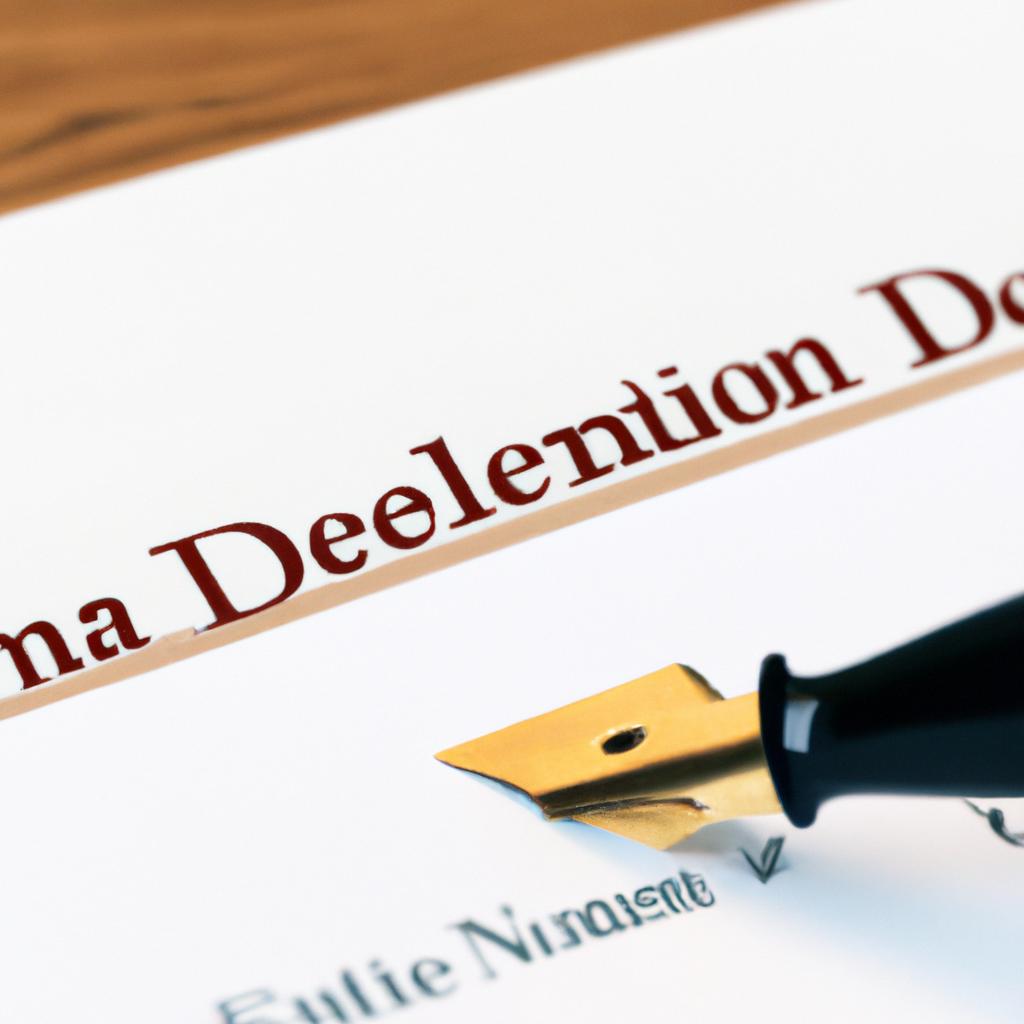In the intricate tapestry of property ownership, the inclusion of one’s name on a deed holds significant legal and financial implications. Whether seeking to untangle joint ownership disputes, protect assets, or embark on a strategic estate planning journey, the process of removing a name from a deed requires careful consideration and expert guidance. As seasoned practitioners well-versed in the complexities of real estate law, our team at Morgan Legal Group stands ready to act as your knowledgeable ally in navigating this intricate terrain. Join us as we delve into the nuanced steps and considerations involved in the art of removing a name from a deed, ensuring a seamless transition towards your desired property ownership goals.
Understanding the Implications of Removing a Name from a Deed
When considering the implications of removing a name from a deed, it is crucial to understand the legal process involved and the potential consequences that may arise. One must carefully consider the reasons for wanting to remove a name from a deed, as it can have significant repercussions on ownership rights and financial obligations. Additionally, it is important to consult with a qualified legal professional, such as the experienced attorneys at Morgan Legal Group in New York City, to ensure that the process is done correctly and in compliance with all relevant laws and regulations.
Before proceeding with the removal of a name from a deed, it is essential to thoroughly review the deed itself to determine the implications of such a change. It is also important to consider any potential tax consequences that may result from the removal of a name from the deed. Consulting with a knowledgeable attorney can help navigate these complexities and ensure that the process is carried out effectively. At Morgan Legal Group, our team of experts is dedicated to providing comprehensive legal assistance in estate planning, probate, elder law, Wills, and trusts, including guidance on removing a name from a deed.

Exploring Legal Options for Removing a Name from a Deed
Removing a name from a deed can be a complex legal process that requires careful consideration and proper execution. There are several options available for individuals seeking to remove a name from a deed, depending on the specific circumstances and legal requirements involved. One common method is through a quitclaim deed, which allows one party to release their interest in a property to another without making any guarantees about the title. Another option is a judicial sale, where the property is sold through a court-supervised process to remove a party’s name from the deed.
It is important to consult with a knowledgeable attorney to discuss the best course of action for removing a name from a deed. A skilled legal professional can evaluate the situation, review relevant documents, and advise on the most effective strategy to achieve the desired outcome. By seeking expert guidance and exploring all available legal options, individuals can navigate the process of removing a name from a deed with confidence and peace of mind.
Considerations Before Removing a Name from a Deed
Before removing a name from a deed, it is important to carefully consider the implications and potential consequences of such action. Here are some key considerations to keep in mind:
- Consult with a legal professional: It is crucial to seek advice from a knowledgeable attorney who specializes in real estate law before making any changes to a deed. A lawyer can provide valuable guidance on the legal process, potential tax implications, and any other relevant factors.
- Understand the impact on ownership: Removing a name from a deed can have significant ramifications on ownership rights and responsibilities. Make sure to fully understand how the change will affect the property’s ownership structure and any joint tenancy agreements.
Additionally, it is essential to review any existing mortgage agreements, liens, or other encumbrances on the property that may be impacted by the removal of a name from the deed. Consider all possible scenarios and consult with all involved parties to ensure a smooth and legally sound transition. By taking these considerations into account and seeking professional guidance, you can navigate the process of removing a name from a deed with confidence and clarity.

Steps to Successfully Remove a Name from a Deed
Removing a name from a deed is a meticulous process that requires thorough attention to detail and adherence to legal procedures. To successfully remove a name from a deed, there are several important steps that must be followed:
- Review the deed: The first step is to carefully review the current deed to understand the ownership structure and determine the names that need to be removed.
- Consult an attorney: It is highly recommended to seek the guidance of an experienced real estate attorney who can provide expert advice and help navigate the legal requirements for removing a name from a deed.
- Prepare a deed transfer document: Once the decision has been made to remove a name from the deed, a deed transfer document must be prepared to reflect the change in ownership.
- Obtain signatures: All parties involved in the deed must sign the transfer document in the presence of a notary public to ensure its validity.
- Record the transfer: The final step is to record the transfer document with the appropriate county or city office to officially remove the name from the deed.
By following these steps and enlisting the help of a knowledgeable attorney, individuals can successfully remove a name from a deed and ensure that the property ownership is accurately reflected in legal documents. Contact the Morgan Legal Group in New York City for assistance with estate planning, property transfers, and other real estate legal matters.
For a free consultation, call us at (212) 561-4299 or visit our website at www.morganlegalny.com.
| Name | Location | |
|---|---|---|
| John Doe | New York City | johndoe@example.com |
| Jane Smith | Manhattan | janesmith@example.com |
Q&A
Q: Can I remove my name from a property deed if I no longer want to be a co-owner?
A: Yes, it is possible to remove your name from a deed if you no longer wish to be a co-owner of the property.
Q: What is the process for removing a name from a property deed?
A: The process typically involves filing a quitclaim deed, which legally transfers ownership of the property from you to the other owner or owners.
Q: Are there any legal requirements or restrictions that I should be aware of?
A: It is important to consult with a legal professional to ensure that the process is done correctly and in accordance with state laws. Additionally, some lenders may require approval before removing a name from a deed.
Q: What are the potential consequences of removing my name from a property deed?
A: Removing your name from a property deed may have tax implications and could affect your ownership rights and financial status. It is important to consider all possible consequences before taking action.
Q: Is it possible to remove a name from a deed without the consent of the other owner(s)?
A: In most cases, all parties must agree to the removal of a name from a deed. If one party refuses to consent, legal action may be necessary to resolve the issue.
Insights and Conclusions
As you navigate the process of removing a name from a deed, remember that you are taking an important step towards safeguarding your assets and securing your financial future. By following the necessary steps and seeking professional guidance as needed, you can ensure a smooth and successful transition. Good luck on your journey to reclaiming ownership of your property and shaping your financial landscape to reflect your goals and aspirations.
 How to Remove Name from Deed: A Comprehensive Guide
How to Remove Name from Deed: A Comprehensive Guide
Have you recently gone through a divorce or had a change in ownership of your property? Are you wondering how to remove a name from the deed of your property? Removing a name from a deed can be a complicated and confusing process, but it is necessary in certain situations. In this article, we’ll walk you through the steps you need to take to remove a name from a deed and provide valuable insights to make the process easier. So, let’s dive in!
Before we get into the steps, let’s start with the basics.
What is a Deed?
A deed is a legal document that proves ownership of a property. It contains important information such as the names of the property owners, the property’s legal description, and any relevant transfer details. A deed is typically issued when a property is purchased or transferred. A deed is a crucial document, as it serves as proof of ownership and can be used in legal matters.
Reasons for Removing a Name from Deed
There can be various reasons why you may want to remove a name from a deed. Some of the common reasons include:
1. Divorce or Separation: If you have gone through a divorce or a separation, you may need to remove your spouse’s name from the deed if they are giving up their stake in the property.
2. Inheritance: If you have inherited a property with multiple owners, you may want to remove one or more names from the deed.
3. Refinancing: When you refinance your property, you may want to remove a name from the deed to transfer the sole ownership to the new owner.
Now that you have a basic understanding of a deed and reasons for removing a name from it, let’s move on to the necessary steps.
Step 1: Gather Important Documents
Before you begin the process of removing a name from the deed, you’ll need to gather all the important documents related to your property. These documents may include the original deed, the divorce decree or separation agreement (if applicable), and any other relevant paperwork. It is essential to have these documents on hand as they will be required during the process.
Step 2: Contact Your Lender
If you have a mortgage on the property you want to remove a name from, you’ll need to contact your lender. Your lender may be able to provide you with the necessary information and paperwork required to remove a name from the deed.
Step 3: Draft a Quitclaim Deed
A quitclaim deed is a legal document used to transfer ownership of a property from one party to another. In this case, it is used to remove a name from the deed without transferring the property to anyone else. It is crucial to have a proper and legally binding quitclaim deed to ensure a smooth and valid transfer of ownership.
While it is possible to draft a quitclaim deed yourself, it is highly recommended to seek the assistance of a lawyer to ensure all legal aspects are properly addressed. Alternatively, you can use an online service provider to draft a quitclaim deed for you.
Step 4: Sign and Notarize the Quitclaim Deed
After drafting the quitclaim deed, all parties involved in the transfer must sign it. This includes the person who is removing their name from the deed, the new owner (if applicable), and any other parties mentioned in the deed. The signatures must be notarized to certify the document’s authenticity and ensure it is legally binding.
Step 5: File the Quitclaim Deed
After the quitclaim deed is notarized, it must be filed with the county recorder’s office in the county where the property is located. Each state may have different requirements for filing a quitclaim deed, so it’s best to consult a lawyer or conduct thorough research on your state’s laws.
Step 6: Inform Other Relevant Parties
After the quitclaim deed is filed, it is crucial to inform other relevant parties about the change in ownership. This may include your homeowner’s insurance provider, homeowner’s association, and local government office.
Additional Tips and Advice
1. Verify the Legal Description: Before filing the quitclaim deed, make sure to double-check the property’s legal description to ensure it is accurate. Any error in the legal description can lead to legal complications in the future.
2. Seek Legal Advice: As mentioned earlier, it is always advisable to seek legal advice when dealing with property ownership matters. A lawyer can guide you through the process, ensuring everything is done correctly and legally.
3. Keep All Records: It is essential to keep all the paperwork and records related to the transfer of ownership for future reference and legal purposes.
In Conclusion
Removing a name from a deed is a significant legal process that requires careful attention to detail. It is vital to follow the steps mentioned above correctly to ensure a smooth and legal transfer of ownership. As always, it’s best to consult a lawyer if you have any doubts or concerns about the process.
We hope this comprehensive guide on how to remove a name from a deed has provided you with valuable insights and made the process more manageable. With the right knowledge and guidance, you can successfully remove a name from the deed of your property. Good luck!

